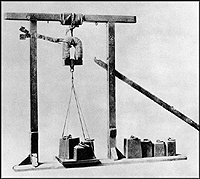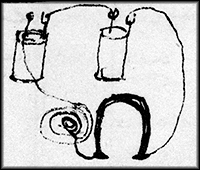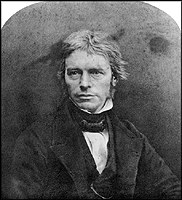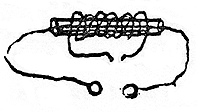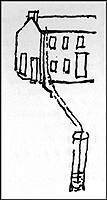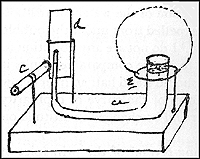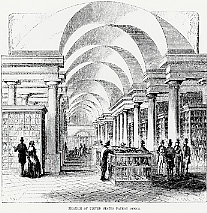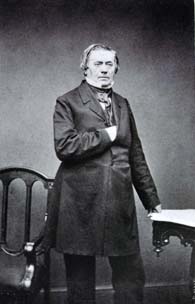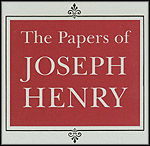
Return to Home Page THE PAPERS OF JOSEPH HENRYPublished VolumesBelow is a brief description of the contents of each volume of The Papers of Joseph Henry completed to date. For volume 7, you may link to an online "mini edition" that includes an introduction and a selection of documents. For volume 8, you may link to the full table of contents and the introduction.
Volume 1, The Albany Years: December 1797-October 1832 (Washington, 1972: ISBN 0-87474-123-8) deals with the formative years of Henry's career. It documents the influence of the Albany, New York, milieu on his scientific growth, and traces the origin and early development of the Albany Academy, where Henry studied and taught, and the Albany Institute, the forum for his early scientific work. A prominent theme of the volume is the proper application of science to technology. In 1831, Henry constructed an electromagnet for Benjamin Silliman of Yale to exhibit before his students. The magnet, which had a lifting power of 2,000 pounds, is now in the Smithsonian Institution.
Volume 2, The Princeton Years: November 1832-December 1835 (Washington, 1975: ISBN 0-87474-164-5) concerns Henry's adjustment to a small college town and his attempts to develop a first-rate facility for teaching and research in the physical sciences. It details his excursions to New York City and Philadelphia in search of scientific apparatus and scientific fellowship, and reveals the beginnings of his lifelong friendships with leading scientists in the latter city, where he became active in the American Philosophical Society and the Franklin Institute. The volume contains many selections from Henry's "Record of Experiments" (the title of his laboratory notebooks), which together with his correspondence give insight into his pioneering work on electromagnetic self-induction and his construction of electromagnets and other equipment needed to pursue his researches. The entry containing this sketch (left) reads: "The current passed through a galvanic magnet no increased effect perceived in the spark--current passed in the opposite direction no increased effect."
Volume 3, The Princeton Years: January 1836-December 1837 (Washington, 1979: ISBN 0-87474-174-2) focuses on Henry's travels to the principal scientific centers of Great Britain and France. During his stay, Henry attended lectures at technical societies, and toured lighthouses, harborworks, and railroad facilities. His diary entries contain appraisals of such European luminaries as J. L. Gay-Lussac, Mary Somerville, Charles Wheatstone, Charles Babbage, and Michael Faraday, and reveal his interest in the way European industry and commerce made use of scientific findings. He also comments on manners and morals, especially in London and Paris. His reactions to the European experience betray a tension between admiration for European advances and a competitive desire for Americans to catch up scientifically and technologically. Volume 4, The Princeton Years: January 1838-December 1840 (Washington, 1981: ISBN 0-87474-792-9) demonstrates Henry's growing concern with the nation's intellectual image abroad. After returning from Europe, he was increasingly sensitive to American shortcomings, particularly to the problem of scientific charlatanism. His opposition to the physician-inventor Henry Hall Sherwood, documented in the volume, epitomized this delicate issue. His fears of quackery, as well as of well-intentioned but misguided amateurism, colored his views of scientific organization and imparted a preference for hierarchical forms in which serious professionals like himself remained in control.
In his research, Henry progressed steadily in his understanding of electromagnetic induction, and his investigations provided the basis for portions of his series "Contributions to Electricity and Magnetism." His laboratory notebooks of this period also reveal an interest in metallic capillarity, electroacoustics, and optics. The entry containing the sketch at left reads: "Put helix of long wire wrapped around a glass rod into long gas pipe, which was magnetized."
Volume 5, The Princeton Years: January 1841-December 1843 (Washington, 1985: ISBN 0-87474-793-7) provides a detailed picture of Henry's daily life as a college professor and leader of the American scientific community: teaching, experimenting, presenting his results to his peers, and lecturing to the public. In addition to continuing his research on electromagnetism, he investigated such phenomena as thermoelectricity, capillarity, phosphorescence, and optical polarization. Applying his knowledge to practical problems, he advised Samuel F. B. Morse during the development of the Morse telegraph, and responded to inquiries about the best forms of lightning rods. The sketch to the right from an entry in "Record of Experiments" headed "Induction from a thunder cloud," reads "I connected by soldering a copper wire (bell size) to the tin roof of our house and passed the lower extremity into the water of the well." The volume also details Henry's role in the choice of Alexander Dallas Bache as head of the U.S. Coast Survey.
Volume 6, The Princeton Years: January 1844-December 1846 (Washington, 1992: ISBN 1-56098-112-1) further develops the theme of Henry as a consultant on technological problems of his day. He provided expert advice on the acoustics of public buildings, the protection of buildings from lightning, the electromagnetic telegraph, and Colt's submarine battery. He also chaired the Franklin Institute committee that investigated the causes of the explosion of Robert Stockton's experimental gun, the "Peacemaker." The volume contains the final major installments of Henry's personal scientific research, and includes a student's perspective on Henry's teaching through the diary of John R. Buhler. The volume also documents the campaign led by Alexander Dallas Bache to elect Henry as the first secretary of the Smithsonian Institution.
Volume 7, The Smithsonian Years: January 1847-December 1849 (Washington, 1996: ISBN 1-56098-533-X) documents the beginning of the most influential period of Henry's life, his thirty-one years as Secretary of the Smithsonian Institution. During these years, Henry strove to ensure that James Smithson's bequest was used to support original scientific research and publication, rather than to create a national museum or library--notions then advocated by many prominent Americans. Henry's diary entries and letters attest to his continuing effort to acquire support from the Smithsonian regents, Congress, scientists, and the American public for his program and his vision of a place for science in a democracy. The volume illuminates the challenges Henry faced in implementing his program without national precedents, adequate resources, or an experienced staff. To view a selection of documents from volume 7, plus an introduction to the volume, go to web site of the Model Editions Partnership.
Volume 8, The Smithsonian Years: January 1850-December 1853 (Washington, 1998: ISBN 1-56098-891-6) reveals a difficult period in Henry's life. During these years, he suffered constant personal and financial woes, clashed with subordinates, and faced significant public criticism of his leadership. When Senator Stephen A. Douglas of Illinois attacked the Smithsonian for its preoccupation with research of "no practical bearing," such as studies of "sea weeds and such trash," Henry mounted a vigorous and eloquent defense of basic research. To ensure the Smithsonian's adherence to what Henry saw as its central mission, he remained at the institution despite the criticism and despite offers of prestigious positions at the University of Pennsylvania, the University of Virginia, and the College of New Jersey at Princeton. The volume records several milestones in the Smithsonian's history. The first was Henry's hiring of assistant secretary Spencer Baird, who energetically expanded the institution's collections of animal, plant, mineral, and fossil specimens. Also during this period, Henry established a system with institutions abroad for the exchange of publications in the biological and physical sciences, ethnology, archaeology, and paleontology. The international exchange program became a fundamental Smithsonian enterprise for more than a century. In addition, Henry began to campaign to place scientific research, publishing, and a meteorological observation network ahead of museum and library collections in terms of funding priorities.
Volume 9, The Smithsonian Years: January 1854-December 1857 (Science History Publications/USA, 2002: ISBN 0-88135-363-9) documents Henry's clash with Assistant Secretary Charles C. Jewett over the purpose and future direction of the Smithsonian. Their dispute would erupt into a public battle fought in newspapers and literary journals in New York, Boston, and Washington, and in the halls of Congress. As the controversy took on national dimensions, it became entangled in partisan politics and broader issues of the decade, particularly the ever-deepening sectional conflict and the problem of cultural elitism in a democracy. Henry would eventually win the dispute and keep intact his vision of an institution dedicated to basic research. But even as he emerged with his authority strengthened, Henry would initiate a relationship between the Smithsonian and the federal government that threatened to undermine his vision. Although Henry believed that the Smithsonian and the federal government "should through all time be kept separate and the former be preserved from political influence," for reasons that have not been clear until now he allowed the Smithsonian to become overseer of the United States National Museum. Volume 9 includes documents that shed new light on Henry's motivations for accepting the national collections in 1857, beginning the process by which, in one historian's view, "activities in research became largely overshadowed by the care of the contents of what was to become aptly described as the nation's attic."
Volume 10, The Smithsonian Years: January 1858-December 1865 (Science History Publications/USA, 2004: ISBN 0-88135-358-2) shows Henry struggling to cope with the impact of the Civil War, the death of his only son, William, the loss of his mentor and confidant, Alexander Dallas Bache, to a mental disease, and the destruction by fire of part of the Smithsonian Institution Building. Henry's opinions on race, democracy, and American society emerge in this volume as he reflected on the events leading to the Civil War. Despite viewing the conflict as unnecessary, Henry would make many contributions to the Union effort. The volume documents his service on a wartime commission to evaluate inventions and proposals for the Navy Department, his role assisting the government as a charter member of the National Academy of Sciences, and his work aiding maritime navigation as a member of the United States Light-House Board. Throughout the volume, one sees the central role Henry played in the organization of American science--from attempting to resolve a controversy over the Dudley Observatory in New York, to ensuring the survival of the fledgling National Academy of Sciences, to the restoration of a national scientific community after the war.
For information on ordering volumes of The Papers of Joseph Henry, please see the home page of our publisher, Science History Publications. JHPP Home || IHD Home || Smithsonian Institution Archives Home |
